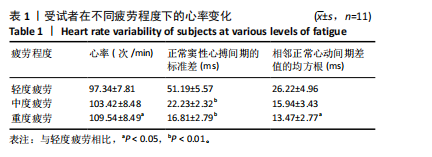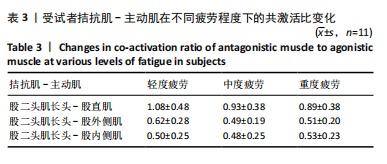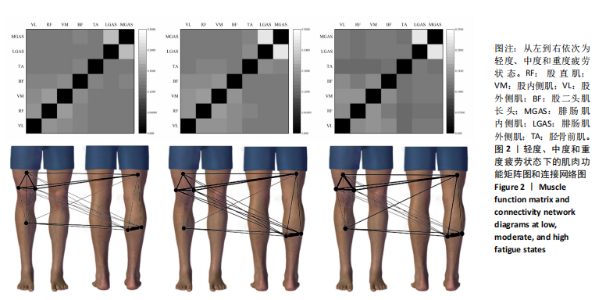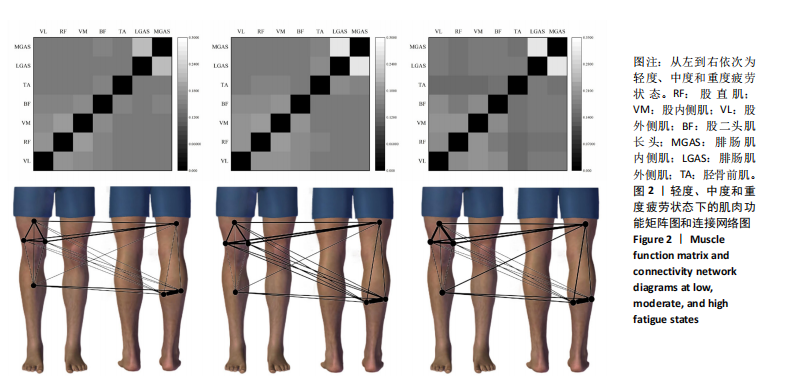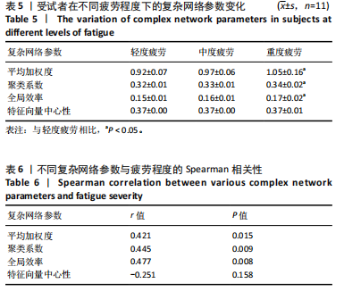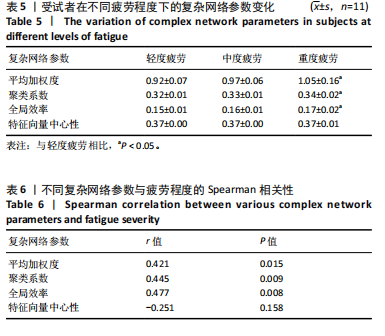Chinese Journal of Tissue Engineering Research ›› 2025, Vol. 29 ›› Issue (12): 2513-2520.doi: 10.12307/2025.392
Previous Articles Next Articles
Topological characteristics of muscle functional networks during repeated leg press to exhaustion
Zhang Chen1, Ran Linghua2, 3, Hu Huimin2, 3, Zhang Xin2, 3, Zhou Zijian4, Xu Hongqi1, Shi Jipeng1
- 1Research Centre for Assessment and Enhancement of Athletic Ability, School of Physical Education and Sports, Northeast Normal University, Changchun 130024, Jilin Province, China; 2Ergonomics Laboratory, China National Institute of Standardization, Beijing 100191, China; 3SAMR Key Laboratory of Human Factors and Ergonomics, China National Institute of Standardization, Beijing 100820, China; 4School of Instrumentation Science and Electrical Engineering, Jilin University, Changchun 130061, Jilin Province, China
-
Received:2024-04-25Accepted:2024-06-11Online:2025-04-28Published:2024-09-10 -
Contact:Xu Hongqi, PhD, Professor, Doctoral supervisor, Research Centre for Assessment and Enhancement of Athletic Ability, School of Physical Education and Sports, Northeast Normal University, Changchun 130024, Jilin Province, China -
About author:Zhang Chen, Master candidate, Research Centre for Assessment and Enhancement of Athletic Ability, School of Physical Education and Sports, Northeast Normal University, Changchun 130024, Jilin Province, China -
Supported by:National Key R&D Program of China, No. 2023YFF0615902 (to RLH); Open Fund of the Key Laboratory of Human Factors and Ergonomics for State Market Regulation, No. 2023SYSKF02002 (to XHQ); Technology Plan Project of State Administration for Market Regulation, No. 2023MK192 (to HHM); the Fundamental Research Funds for the Central Universities, No. 522023Y-10381 (to HHM)
CLC Number:
Cite this article
Zhang Chen, Ran Linghua, Hu Huimin, Zhang Xin, Zhou Zijian, Xu Hongqi, Shi Jipeng. Topological characteristics of muscle functional networks during repeated leg press to exhaustion[J]. Chinese Journal of Tissue Engineering Research, 2025, 29(12): 2513-2520.
share this article
Add to citation manager EndNote|Reference Manager|ProCite|BibTeX|RefWorks
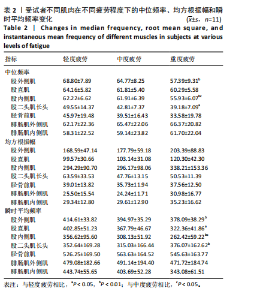
2.3 肌电一般指标 表2为3种疲劳程度下不同肌肉的肌电中位频率、均方值振幅和瞬时平均频率的变化。对于中位频率,股外侧肌、股内侧肌的轻度疲劳与重度疲劳之间存在非常显著性差异(P < 0.01),股二头肌长头的轻度疲劳与重度疲劳之间存在显著性差异(P < 0.05),股内侧肌的中度疲劳与重度疲劳之间也存在显著性差异(P < 0.05)。不同肌肉在不同疲劳程度下的均方值振幅均不存在显著性差异(P > 0.05)。对于瞬时平均频率,股外侧肌、股内侧肌和股二头肌长头在轻度疲劳和重度疲劳之间表现出非常显著性差异(P < 0.01),股直肌在轻度和重度疲劳之间表现出显著性差异(P < 0.05),股内侧肌在中度疲劳和重度疲劳之间也存在显著差异(P < 0.05)。"
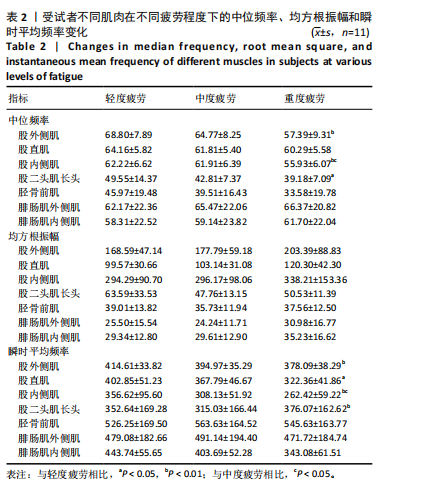
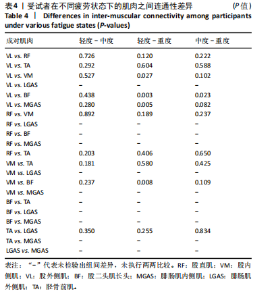
2.5 功能网络 2.5.1 功能网络建立 图2显示了3种疲劳程度下的肌肉连通矩阵图和网络图,网络图各节点的连通线粗细与连通强度呈正比。轻度疲劳程度下,各个肌肉连通强度之间相对均匀。随着疲劳程度的上升,各个肌肉之间的整体连通强度增加,尤其表现在腓肠肌外侧肌和腓肠肌内侧肌的连通强度增加,股外侧肌、股直肌和股内侧肌的连通强度也增加。 为了进一步探究3种疲劳程度连通强度差异,表4为单因素重复测量方差分析结果,其中“-”代表未检验出组间差异,未执行两两比较。股外侧肌-股内侧肌的轻度疲劳与重度疲劳之间存在显著性差异(P < 0.05),股外侧肌-股二头肌长头、股外侧肌-腓肠肌内侧肌、股内侧肌-股二头肌长头的轻度疲劳与重度疲劳之间存在非常显著性差异(P < 0.01),股外侧肌-股二头肌长头的中度疲劳与重度疲劳之间存在显著性差异(P < 0.05)。"
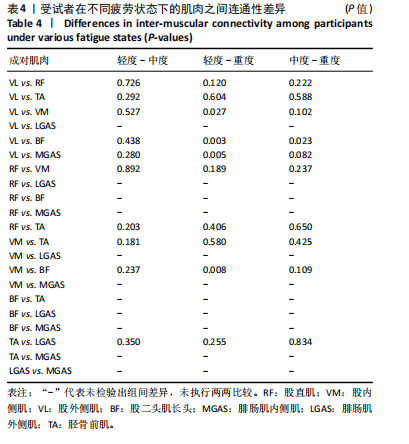
| [1] 胡海旭.竞技能力增长理论模型及其演进[J].体育科学,2016,36(2): 14-24+40. [2] RUSSELL S, JOHNSTON RD, STANIMIROVIC R, et al. Global practitioner assessment and management of mental fatigue and mental recovery in high-performance sport: A need for evidence-based best-practice guidelines. Scand J Med Sci Sports. 2024;34(1):e14491. [3] YODA IK, TISNA GD, SUWIWA IG, et al. Recovery methods to reduce fatigue among athletes: A systematic review and future directions. J Sport Area. 2024;9(2):217-234. [4] SCHLINK BR, NORDIN AD, BROOKS CN, et al. Fatigue induces altered spatial myoelectric activation patterns in the medial gastrocnemius during locomotion. J Neurophysiol. 2021;125(5):2013-2023. [5] GANTOIS P, CAPUTO FERREIRA ME, LIMA-JUNIOR D, et al. Effects of mental fatigue on passing decision-making performance in professional soccer athletes. Eur J Sport Sci. 2020;20(4):534-543. [6] MCCLEAN ZJ, PASANEN K, LUN V, et al. A Biopsychosocial Model for Understanding Training Load, Fatigue, and Musculoskeletal Sport Injury in University Athletes: A Scoping Review. J Strength Cond Res. 2024;38(6):1177-1188. [7] SAYYADI P, MINOONEJAD H, SEIDI F, et al. The effectiveness of fatigue on repositioning sense of lower extremities: systematic review and meta-analysis. BMC Sports Sci Med Rehabil. 2024;16(1):35. [8] SUN J, LIU G, SUN Y, et al. Application of Surface Electromyography in Exercise Fatigue: A Review. Front Syst Neurosci. 2022;16:893275. [9] LI N, ZHOU R, KRISHNA B, et al. Non-invasive Techniques for Muscle Fatigue Monitoring: A Comprehensive Survey. ACM Comput Surv. 2024;56(9):1-40. [10] NAIR RR, VENUGOPAL G, SWAMINATHAN R. Analysis of Muscle Fiber Type Proportions in Surface Electromyography Signals of Athletes Using Reassigned Morlet Scalogram. IEEE Trans Instrum Meas. 2024;73(1-10): 6502710. [11] 徐红旗,史冀鹏,张守伟,等. sEMG时频特征线性回归法与非线性神经网络法预测伸膝肌群极限功率保持能力测试中功率损失率的比较研究[J].中国体育科技,2017,53(2):53-63. [12] 徐红旗,史冀鹏,张欣,等.表面肌电小波变换分析技术监测重复性手工提放重物作业中机体肌肉疲劳的研究[J].体育科学,2011, 31(12):44-54. [13] YOON W, SHIN G. Muscle fatigue tracking during dynamic elbow flexion-extension movements with a varying hand load. Appl Ergon. 2024;116:104217. [14] WANG C, WANG X, LI Q, et al. Recognizing and predicting muscular fatigue of biceps brachii in motion with novel fabric strain sensors based on machine learning. Biomed Signal Process Control. 2024;96: 106647. [15] SHARIATZADEH MJ, HAFSHEJANI EH, MITCHELL CJ, et al. Predicting muscle fatigue during dynamic contractions using wavelet analysis of surface electromyography signal. Biocybern Biomed Eng. 2023;43(2): 428-441. [16] DANIEL N, MAŁACHOWSKI J. Wavelet analysis of the EMG signal to assess muscle fatigue in the lower extremities during symmetric movement on a rowing ergometer. Acta Bioeng Biomech. 2023;25(2): 15-27. [17] HOFSTE A, SOER R, SALOMONS E, et al. Intramuscular EMG Versus Surface EMG of Lumbar Multifidus and Erector Spinae in Healthy Participants. Spine (Phila Pa 1976). 2020;45(20):E1319-E1325. [18] ORTEGA-AURIOL PA, BESIER TF, BYBLOW WD, et al. Fatigue Influences the Recruitment, but Not Structure, of Muscle Synergies. Front Hum Neurosci. 2018;12:217. [19] ZHAO K, ZHANG Z, WEN H, et al. Muscle synergies for evaluating upper limb in clinical applications: A systematic review. Heliyon. 2023; 9(5):e16202. [20] 陈仕吉,崔腾腾,邱均平.学科交叉动力学分析研究综述[J].数据分析与知识发现,2022,6(5):1-9. [21] 肖汉,张艳花,山洁,等.基于社会网络分析的高校图书馆图书资源利用研究[J].图书馆理论与实践,2020(5):26-30,51. [22] 郭峰,袁维帅,王新,等.视觉对人体姿势控制影响的脑功能网络连接机制[J].医用生物力学,2024,39(2):285-292. [23] 崔彩虹,缪华聪,梁铁,等.基于表面肌电信号的不同步行速度下肌肉协同及肌肉功能网络分析[J].生物医学工程学杂志,2023,40(5): 938-944.
[24] 陈玲玲,张存,宋晓伟,等.面向外骨骼机器人的肌肉功能网络构建及分析[J].生物医学工程学杂志,2019,36(4):565-572. [25] O’KEEFFE R, SHIRAZI SY, MEHRDAD S, et al. Perilaryngeal functional muscle network in patients with vocal hyperfunction-a case study. Baltimore:Proceedings of the 2023 11th International IEEE/EMBS Conference on Neural Engineering (NER), 2023. [26] HOUSTON M, LI X, ZHOU P, et al. Alterations in Muscle Networks in the Upper Extremity of Chronic Stroke Survivors. IEEE Trans Neural Syst Rehabil Eng. 2021;29:1026-1034. [27] NAGAI T, SCHILATY ND, LASKOWSKI ER, et al. Hop tests can result in higher limb symmetry index values than isokinetic strength and leg press tests in patients following ACL reconstruction. Knee Surg Sports Traumatol Arthrosc. 2020;28(3):816-822. [28] BORG G. Borg’s perceived exertion and pain scales. Champaign: Human Kinetics, 1998. [29] HERMENS HJ, FRERIKS B, DISSELHORST-KLUG C, et al. Development of recommendations for SEMG sensors and sensor placement procedures. J Electromyogr Kinesiol. 2000;10(5):361-374. [30] MIRANDA H, MAIA M, DE OLIVEIRA CG, et al. Myoeletric indices of fatigue adopting different rest intervals during leg press sets. J Bodyw Mov Ther. 2018;22(1):178-183. [31] HAHN D. Lower extremity extension force and electromyography properties as a function of knee angle and their relation to joint torques: implications for strength diagnostics. J Strength Cond Res. 2011;25(6):1622-1631. [32] AUGUSTSSON J, THOMEÉ R, HÖRNSTEDT P, et al. Effect of pre-exhaustion exercise on lower-extremity muscle activation during a leg press exercise. J Strength Cond Res. 2003;17(2):411-416. [33] XU HQ, XUE YT, ZHOU ZJ, et al. Retentive capacity of power output and linear versus non-linear mapping of power loss in the isotonic muscular endurance test. Sci Rep. 2021;11(1):22677. [34] CICCONE AB, SIEDLIK JA, WECHT JM, et al. Reminder: RMSSD and SD1 are identical heart rate variability metrics. Muscle Nerve. 2017;56(4): 674-678. [35] 吴成亮,郝卫亚,李旭鸿,等.体操运动员后空翻落地与垂直落地的下肢生物力学比较研究[J].中国体育科技,2022,58(5):21-26+83. [36] 李萍,朱学强,李秀红,等.运动损伤预防训练对短跑运动员下肢生物力学和共激活特征的影响[J].中国体育科技,2021,57(11):30-37. [37] 王元东.运动想象中的大脑网络可塑性研究[D].济南:齐鲁工业大学,2023. [38] 张夏冰.上肢动作相关脑、肌电生理网络研究[D].成都:电子科技大学,2023. [39] RUBINOV M, SPORNS O. Complex network measures of brain connectivity: uses and interpretations. Neuroimage. 2010;52(3):1059-1069. [40] 李海林,陈多,林伟滨.合作网络整体性特征对科研团队创新绩效的影响研究:以(国际)医学信息学领域研究论文为例[J].情报科学,2023,41(5):59-67. [41] 赵霞,李会会.经济政策不确定性与股票市场存在双向溢出效应吗?:基于尾部风险网络的视角[J].上海对外经贸大学学报, 2023,30(5):92-106. [42] CHEN Z, YAN J, SONG X, et al. Heavier Load Alters Upper Limb Muscle Synergy with Correlated fNIRS Responses in BA4 and BA6. Cyborg Bionic Syst. 2023;4:0033. [43] ZHAO H, SEO D, OKADA J. Validity of using perceived exertion to assess muscle fatigue during back squat exercise. BMC Sports Sci Med Rehabil. 2023;15(1):14. [44] GAO Z, ZHAO L, FEKETE G, et al. Continuous time series analysis on the effects of induced running fatigue on leg symmetry using kinematics and kinetic variables: Implications for knee joint injury during a countermovement jump. Front Physiol. 2022;13:877394. [45] JOHN AT, WIND J, HORST F, et al. Acute Effects of an Incremental Exercise Test on Psychophysiological Variables and Their Interaction. J Sports Sci Med. 2020;19(3):596-612. [46] HALPERIN I, EMANUEL A. Rating of Perceived Effort: Methodological Concerns and Future Directions. Sports Med. 2020;50(4):679-687. [47] 麦全安,张勇.网球锻炼对老年人平衡能力影响的实验研究[J].体育学刊,2019,26(4):140-144. [48] 王宏棣,周志芳,何金存,等.运动员运动生理生化指标与体育木地板运动功能的相关性[J].林业科学,2020,56(1):172-179. [49] 朱欢,高炳宏.微血管反应性在耐力性运动员训练中的应用[J].中国运动医学杂志,2019,38(10):907-914. [50] 易灿南,唐范,左华丽,等.基于sEMG的拉物行走作业肌肉疲劳发展机理研究[J].人类工效学,2022,28(1):37-42. [51] TESCH PA, DUDLEY GA, DUVOISIN MR, et al. Force and EMG signal patterns during repeated bouts of concentric or eccentric muscle actions. Acta Physiol Scand. 1990;138(3):263-271. [52] AMENT W, BONGA GJ, HOF AL, et al. Electromyogram median power frequency in dynamic exercise at medium exercise intensities. Eur J Appl Physiol Occup Physiol. 1996;74(1-2):180-186. [53] O’KEEFFE R, SHIRAZI SY, YANG J, et al. Non-parametric Functional Muscle Network as a Robust Biomarker of Fatigue. IEEE J Biomed Health Inform. 2023;27(4):2105-2116. [54] SJÖBERG M, BERG HE, NORRBRAND L, et al. Comparison of Joint and Muscle Biomechanics in Maximal Flywheel Squat and Leg Press. Front Sports Act Living. 2021;3:686335. [55] OSU R, FRANKLIN DW, KATO H, et al. Short- and long-term changes in joint co-contraction associated with motor learning as revealed from surface EMG. J Neurophysiol. 2002;88(2):991-1004. [56] KRISTIANSEN M, SAMANI A, MADELEINE P, et al. Effects of 5 Weeks of Bench Press Training on Muscle Synergies: A Randomized Controlled Study. J Strength Cond Res. 2016;30(7):1948-1959. [57] 张海红,王健.双侧屈伸肘运动中主动肌与拮抗肌的表面肌电图变化[J].中国运动医学杂志,2009,28(4):431-435. [58] 黄耐寒.基于表面肌电的肌疲劳分析与肌力预测研究及实现[D].合肥:中国科学技术大学,2014. [59] HAJILOO B, ANBARIAN M, ESMAEILI H, et al. The effects of fatigue on synergy of selected lower limb muscles during running. J Biomech. 2020;103:109692. [60] 贾彬彬,李丹阳,吕辰楠,等.运动负荷对抗阻训练下皮层神经活动特征的影响:来自fNIRS的证据[J].武汉体育学院学报,2024, 58(2):63-70+80. [61] LIU X, CUI X, LIANG T, et al. Characteristics analysis of muscle function network and its application to muscle compensatory in repetitive movement. Biomed Signal Process Control. 2023;83:104639. [62] CAO L, LI L, HUANG Z, et al. Functional network segregation is associated with higher functional connectivity in endurance runners. Neurosci Lett. 2023;812:137401. |
| [1] | Dong Tingting, Chen Tianxin, Li Yan, Zhang Sheng, Zhang Lei. Causal relationship between modifiable factors and joint sports injuries [J]. Chinese Journal of Tissue Engineering Research, 2025, 29(9): 1953-1962. |
| [2] | Zhou Jinhai, Li Jiangwei, Wang Xuquan, Zhuang Ying, Zhao Ying, Yang Yuyong, Wang Jiajia, Yang Yang, Zhou Shilian. Three-dimensional finite element analysis of anterior femoral notching during total knee arthroplasty at different bone strengths [J]. Chinese Journal of Tissue Engineering Research, 2025, 29(9): 1775-1782. |
| [3] | Li Huayuan, Li Chun, Liu Junwei, Wang Ting, Li Long, Wu Yongli. Effect of warm acupuncture on PINK1/Parkin pathway in the skeletal muscle of rats with chronic fatigue syndrome [J]. Chinese Journal of Tissue Engineering Research, 2025, 29(8): 1618-1625. |
| [4] | Wang Juan, Wang Guanglan, Zuo Huiwu. Efficacy of exercise therapy in the treatment of anterior cruciate ligament reconstruction patients: #br# a network meta-analysis #br# [J]. Chinese Journal of Tissue Engineering Research, 2025, 29(8): 1714-1726. |
| [5] | Chen Jing, Zhang Nan, Meng Qinghua, Bao Chunyu. Material characterization of finite element computational models of knee joints at different ages [J]. Chinese Journal of Tissue Engineering Research, 2025, 29(34): 7369-7375. |
| [6] | Yan Feng, Zhang Nan, Meng Qinghua, Bao Chunyu, Ye Lixin, Yu Jia. Finite element modeling of knee joint based on semi-automatic segmentation technology [J]. Chinese Journal of Tissue Engineering Research, 2025, 29(33): 7055-7062. |
| [7] | Jiang Tao, Zhang Chuankai, Hao Liang, Liu Yong. MAKO robot- and navigation-assisted knee replacement: comparison of lower limb force alignment and prosthesis position accuracy [J]. Chinese Journal of Tissue Engineering Research, 2025, 29(33): 7150-7157. |
| [8] | Gao Yuan, Xiong Zheyu, Zheng Wei, Chen Haonan, Chen Fangyuqing. Lower extremity biomechanical characterization during step-down test in patients with patellofemoral pain [J]. Chinese Journal of Tissue Engineering Research, 2025, 29(32): 6913-6919. |
| [9] | Wang Qifei, Du Xingbin, Kong Jianda. Neural physiological basis and exercise-induced mechanism of central fatigue [J]. Chinese Journal of Tissue Engineering Research, 2025, 29(32): 6979-6988. |
| [10] | Yao Tingfeng, Liu Lin, Liu Shixuan, Lu Xinyue. Meta-analysis of the effectiveness of dry needling at myofascial trigger points in the treatment of knee disorders [J]. Chinese Journal of Tissue Engineering Research, 2025, 29(32): 6989-6996. |
| [11] | Zhang Songjiang, Li Longyang, Zhou Chunguang, Gao Jianfeng. Central anti-inflammatory effect and mechanism of tea polyphenols in exercise fatigue model mice [J]. Chinese Journal of Tissue Engineering Research, 2025, 29(30): 6474-6481. |
| [12] | Zhang Jian, Cai Feng, Li Tingwen, Ren Pengbo. Fatigue gait recognition of athletes based on fish swarm algorithm [J]. Chinese Journal of Tissue Engineering Research, 2025, 29(30): 6489-6498. |
| [13] | Su Dejun, Dong Wanpeng, Dong Yuefu, Zhang Jichao, Zhang Zhen. Design of asymmetric prosthesis and mechanical analysis of total knee arthroplasty [J]. Chinese Journal of Tissue Engineering Research, 2025, 29(3): 510-516. |
| [14] | Chen Jun, Jia Shaohui, Guo Chenggen, Xue Xinxuan, Dong Kunwei. Role and mechanism of resveratrol in delaying exercise-induced fatigue [J]. Chinese Journal of Tissue Engineering Research, 2025, 29(29): 6285-6294. |
| [15] | Hu Zhenghui, Zhang Wen, Heng Hongquan, Ren Weizhi, Wu Chenying, Gu Zenghui, Peng Jian, Li Liubing, Xu Wei. Finite element analysis of application of variable angle screws in posterolateral tibial plateau fractures [J]. Chinese Journal of Tissue Engineering Research, 2025, 29(27): 5735-5742. |
| Viewed | ||||||
|
Full text |
|
|||||
|
Abstract |
|
|||||

